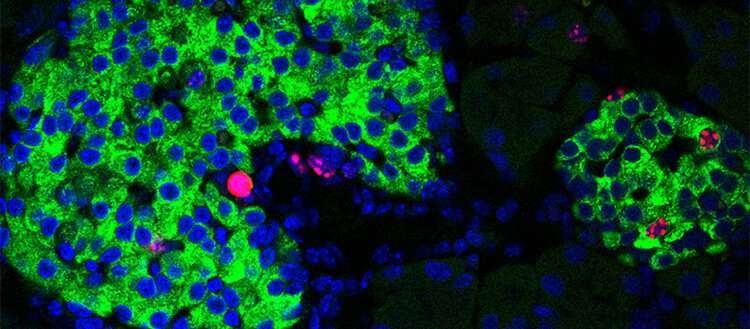
Certain body parts, such as the skin or liver, can repair themselves after damage. Cell regeneration is the phenomenon by which cells that are still functional proliferate to compensate for cellular damage. For the past 30 years, scientists have been investigating the regenerative potential of beta cells, pancreatic cells in charge of the production of insulin. The beta-cell population is indeed partially destroyed when diabetes occurs, and regenerating these cells represents an outstanding clinical challenge.
By studying diabetic mice, scientists from the University of Geneva (UNIGE) and the University Hospitals of Geneva observed that this regeneration mechanism was under the influence of circadian rhythms—the molecular clocks regulating metabolic functions according to a 24-hour cycle of alternating day-night. In addition, the scientists identified the essential role of the core clock component BMAL1 in this process. These results, published in the journal Gene and Development, allow new perspectives to promote beta cell regeneration.
Compensatory proliferation, in which cells actively divide to replace those that have been damaged, is a biological mechanism that is both well-known and poorly understood. “And this is particularly true for pancreatic beta cells, whose regenerative mechanism is still largely unexplored despite decades of research,” explains Dr. Charna Dibner, head of the Circadian Endocrinology Laboratory at UNIGE. “However, deciphering this phenomenon, and above all, finding out how to promote it, could be a game changer for controlling diabetes.”
Day-night rotation is essential
To explore the connection between internal biological clocks and beta cell regeneration, Charna Dibner’s team first observed two groups of mice with only 20% of beta cells remaining after targeted massive ablation. Mice in the first group were arrhythmic, whereas the control group had perfectly functional clocks.
“The result was very clear: The mice bearing dysfunctional clocks were unable to regenerate their beta cells and suffered from severe diabetes, while the control group animals had their beta cells regenerated; in just a few weeks, their diabetes was under control,” says Volodymyr Petrenko, a researcher in Dr. Dibner’s laboratory and the leading scientist in this study. By measuring the number of dividing beta cells over 24 hours, the scientists also noted that regeneration is significantly greater at night, when the mice are active.
The BMAL1 gene, metronome of cell activity
The arrhythmic mice lacked the BMAL1 gene, which codes for the protein of the same name, a transcription factor known for its key action in the functioning of circadian clock. “Our analyses show that the BMAL1 gene is essential for the regeneration of beta cells,” says Petrenko. In addition, large-scale transcriptomic analyses over a 24-hour period, conducted in collaboration with Prof. Bart Vandereycken at the Mathematics Department of the UNIGE, revealed that the genes responsible for regulating cell cycle and proliferation were not only upregulated, but also acquired circadian rhythmicity.
“BMAL1 indeed seems to be central for our investigation,” says Dibner. “However, whether the regeneration requires functional circadian clocks themselves, or only BMAL1, whose range of functions goes beyond clocks remains unclear. That is what we would like to find out at present.”
Source: Read Full Article
